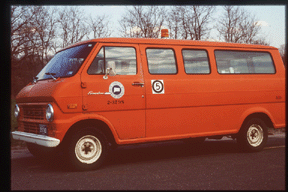Photolog History

ConnDOT started photologging in 1973 as a means to improve inventory data collection, which, to that point, had been acquired manually by field inspectors on foot, or in state cars logging roadway features on the fly with pencil and paper. Automated collection marked a significant step forward. In Connecticut this was accomplished through a 1973 research project supported by the Federal Highway Administration (FHWA). The mode of collection proposed and ultimately implemented was a van instrumented with a 35mm motion picture camera attached to the dashboard and distance measuring sensors on the wheels that triggered the camera to fire every 1/100th of a mile. This resulted in forward facing, driver's-eye-view images. 400-foot film rolls were developed and positive film work prints were cut and spliced into single route/directions, and catalogued by the photolog staff for distribution. In the spring of 1974 the first of three film viewing stations was set up in ConnDOT's Traffic Engineering Division
In the 1980s, the userbase grew to sixteen customized laserdisc-based stations controlled by the then new personal computer (PC) and a graphics generator. The 1990s saw advancements in PC technology significantly lower the cost of individual PC-laserdisc stations to the point where thirty photolog stations were in use throughout the department. ConnDOT had converted to DVD for a time and currently utilizing Agency-wide client-server distribution with roughly 400 - 500 users.

